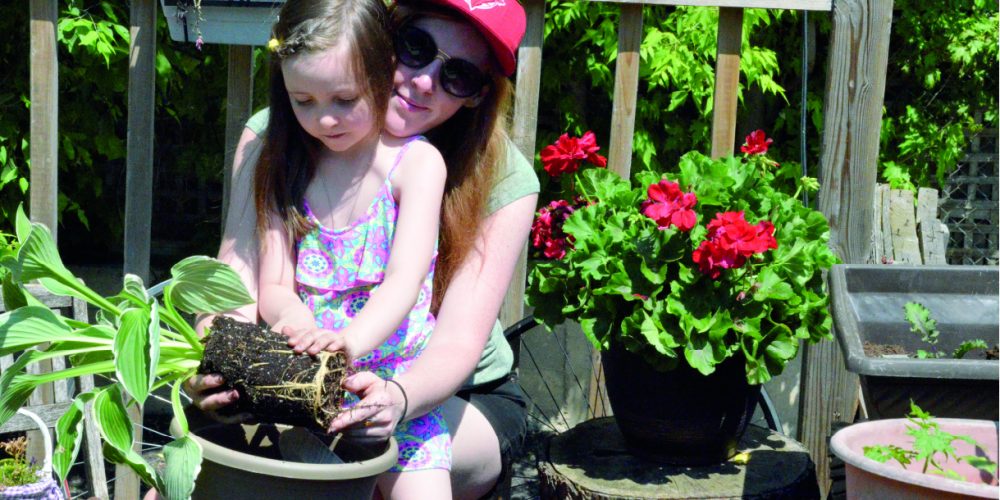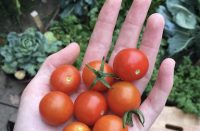Whether on a patio, a balcony, in a backyard, or even in a fish tank, growing an urban garden in the midst of a large metropolis is possible with as little or as much space as you can muster. Gardening isn’t always easy, but once you create your own food, you might just find it deeply satisfying.
Whether on a patio, a balcony, in a backyard, or even in a fish tank, growing an urban garden in the midst of a large metropolis is possible with as little or as much space as you can muster. Gardening isn’t always easy, but once you create your own food, you might just find it deeply satisfying.
I decided to embark on my own urban gardening journey with my six-year-old daughter, Aurora, after she expressed interest in the planting process. Lara Kelly is the owner of Holly Ray Farms, a vegetable consultation business in Toronto, and she believes in the value of introducing children to gardening. “When children are young, they understand so much about the natural world. I’ve never come across a child who, when introduced to gardening, didn’t take to it and love it,” Kelly says. “They all absolutely love watching things grow and they are more connected to the simple joy and awe of it.” Harnessing this joy and awe will promote mini city slickers to love nature and have a healthy relationship with food.
Embracing my daughter’s interest in the world of gardening, I began to plan how to make her dreams of having a green-thumb come true. The first step was to investigate what kind of space I had to build a garden. This is more difficult than it sounds when you are an inner-city urbanite in Toronto. I live above a restaurant (organic luckily) and have a modest patio space behind my apartment. It is tucked between the edge of the building and a small roof that gives me a narrow margin of available room to garden. I refused to be daunted though, since lack of space is a regular issue when living in a large city, and there is always a way around it.
Luckily, plants are flexible in small spaces. Rhonda Teitel-Payne, coordinator of Toronto Urban Growers, a networking hub that brings community groups together for gardening in Toronto, is used to hearing that space is an issue in the city. “Really finding out what works out for your space is the most important thing,” Teitel explains. “There is a lot of experimenting which can be frustrating for first-time growers, but every year you learn more and more.”
Taking her advice, I drew a general plan using my patio space and discovered that I have a lot more room than I thought possible. I headed to the store to buy several vegetables and flowers to put in hanging pots that I suspended alongside the patio. I also purchased a lot of climbers such as peas and long beans that will eventually creep up vertically along the wall to save space. “You can maximize your space by using trellis materials (like climbing rope) against walls to grow vines” Kelly says. “You can completely cover your patio with container gardening as well.”
Watching her little hands dig into the soil and learning how to water the plants inspires me to understand the power of connecting with the Earth’s roots from a young age. “
Patio space isn’t the only way to incorporate plants into an urban garden, and with a little creativity, it is even possible to use your fish tank. Brandon Hebor and Steven Bourne are co-owners of Ripple Farms, a local aquaponics operation run out of Evergreen Brick Works in Toronto. Hebor explains, “Aquaponics is a combination of aquaculture, which is raising an aquatic species, and hydroponics, which is growing without soil. We have tethered two living ecosystems, using the fish poop as an organic fertilizer for our plants.”
Building a DIY aquaponics system is a challenge, but is possible with a few tools and hard work. Ripple Farms is hosting a series of aquaponics workshops with the Toronto Tool Library in the coming months for those interested in learning. Begin by using a 50-to-75-gallon (190-to-285-litre) fish tank for tilapia, koi or another freshwater species. Set up a pumping system that moves water from the fish tank into a media bed on top, or beside the tank. The media bed acts as a zone of biological reaction where “poop water” is converted from “toxic” ammonia to “healthy” nitrate, a primary nutrient for plants to uptake. Water flowing through the media bed passes over the exposed plant roots, allowing them to grow quickly by accessing readily available nutrients.
For the owners of Ripple Farms, the project isn’t just a fun way to garden. The two fish enthusiasts have larger goals when it comes to aquaponics and the importance of gardening as a source of food. “Canada only has three to five days of reserve food on hand. It is scary to think about what would happen to our national food supply if the borders closed up or a disaster occurred. What do we do in that case?” Bourne asks. “Creating a long-term plan for systemic change, we are trying to internalize our food production system. We want to make farming cool again and inspire youth of all ages to put down the phone and plant a seed.”
Whether it is a garden on the balcony or an aquaponics system in a fish tank, deciding to plant edible foods is a good idea. I decided to stay away from more difficult plants such as cauliflower or broccoli, and used food-grade containers so that toxins wouldn’t spread into my veggies. Aurora and I planted chard, black kale, collards, lettuce, and we even challenged ourselves with a large pot of tomatoes.
I also paid special attention to which combination of plants to put together, and made sure to pair deeper-rooted plants with shallow-rooted ones. I learned that some plants help others thrive and some greens shouldn’t be planted together at all. “Certain plants get along with other plants really well such as marigold, which is a good insect repellent and does well in small spaces,” Teitel says. While on the other hand, “Dill has a repellent effect towards other plants.”
Though I was a bit shy to plant fruits my first year, if you are feeling confident in your planting abilities, fruit may be your calling. A well-loved fruit tree will produce fruit for decades. According to the Director of Orchard People Fruit Tree Care Consulting and Education, Susan Poizner, it is even possible to have a fruit tree on a patio as well. “Depending on how big your patio is, you would need a very large pot with a lot of depth,” Poizner says. “If you want to grow a tropical tree like a Meyer lemon, you can keep it inside near a sunny window, in the winter, and then put it on your patio in the summer. I look at fruit trees as beings that we have a two-way relationship with. All we have to do is give them lots of love and correct hands-on care and in return, they will give you a fantastic harvest for years to come.”
Aurora and I look forward to a summer of tending our new garden. Watching her little hands dig into the soil and learning how to water the plants inspires me to understand the power of connecting with the Earth’s roots from a young age. As the plants grow and produce flowers and vegetables, I can’t wait to watch her pride for growing food and understanding how hard work and patience pays off.
“So much of gardening is accepting the lifecycles and seeing something start from a seed to its full lifecycle and then watching it decay,” Kelly says. “There is still life in the decaying process. It helps you in your own experience – dealing with these things as a gardener and in life.” Aurora and I couldn’t agree more, and together we’ll learn about the cycle of life through the world of urban gardening.
To find out more about aquaponics, check out ripplefarms.ca. Toronto Urban Growers is a membership-based network of urban farmers, gardeners, businesses, etc. who are ready to help you start or scale up your food-growing-in-the-city initiatives. torontourbangrowers.org
Kaeleigh Phillips is an environment and sustainability communications writer with a passion for animal rights. A former staff writer for the Women’s Post, Kaeleigh is now the Communications and Outreach Director for Canadian Association of Physicians for the Environment.













